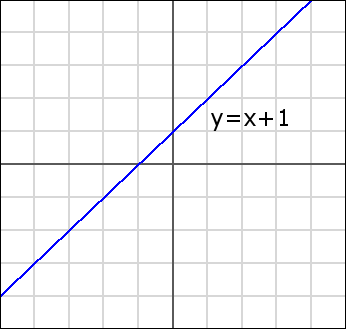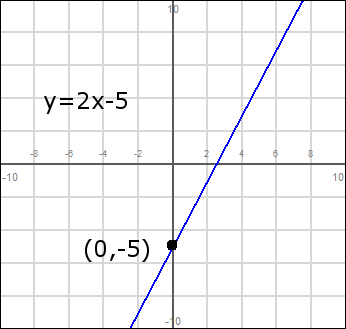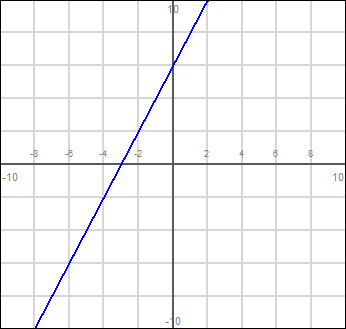What is slope-intercept form?
It's a standard method for writing the equation of a line. It has two variables, x and y, and an unlimited number of "solutions" (the line is infinitely long).
What does it look like?
A line written in slope-intercept form takes this form:
$$ \huge y=mx+b $$Sometimes you'll even hear people refer to slope-intercept as "y=mx+b form" because it's so well known. Let's examine what each term means. Remember that you are plotting this graph on an x-y plane, so the variables x and y represent geometric points on the graph. The constant 'm' is the slope of the graph -- notice how it multiplies your x term. That's because the slope of a graph determines how much 'y' changes as a function of 'x'. The final term, b, is the y-intercept. That's the point at which the line crosses the y-axis, where x=0. If you plug in 0 for x, you'll see that all you have is y=b.
An example:
Q: Plot the line described by this equation: \(y=x+1\)
A: What is the slope of this line? It's the 'm' term in y=mx+b. In this example, m=1. Therefore the slope of the line is 1, or said another way, the line goes "up" one unit every time it goes "over" one unit.
What is the y-intercept of the line? That's the 'b' term, so it's also 1. That means that when x is 0, y=1. Go ahead and plug x=0 into that equation to verify for yourself.

In that example, notice how the line crosses the y-axis (the vertical axis) at y=1? That's the "intercept" part of slope-intercept form.
Let's see something more complicated.
The next example will have some more complicated numbers. However, it's still as simple as reading them from the equation and working through it step-by-step.
Q: Plot the line \(y = 2x - 5\)
A: Ok, so what is the slope? That the 'm', and multiplies the x. In this case it's 2. What's the y-intercept? Notice that it's being subtracted, so the y-intercept is actually -5.
Ok, so how do you actually plot that??
You can start from the y-intercept. We know the line crosses the y-axis at \(y=-5\), so you can plot the point \((0,-5)\).
Then, since the slope is 2, you need to go up two units for every 1 you go over:

Ok, so do you understand the basics now? Just find the y-intercept, and then draw a line with the given slope.
But, sometimes the equation won't be in an easy-to-read \(y=mx+b\) format. Sometimes it will look more complicated. All you have to do is rewrite the equation into that form, like this:
Re-writing into point-slope form:
Q: Plot the line \(y=2*(x+3)\).
A: Rewrite into \(y=mx+b\) format. Multiply the 2 over the parenthesis:
$$ y=2*(x+3) $$ $$ y=2x+6 $$Now we're in the right format, and we can easily plot it

Sometimes you will see the x and y on the same side of the equation, or a term that multiplies y, like this nasty example:
$$ 4y+x=12 $$Like before, just use your basic algebra knowledge to rewrite into \(y=mx+b\) format:
$$ 4y+x = 12 $$ $$ 4y = -x+12 $$ $$ y = -.25x+3 $$Getting the basic hang of it? Check out a similar method of graphing lines, the point-slope format. Or read more lessons on slope intercept from other websites.
